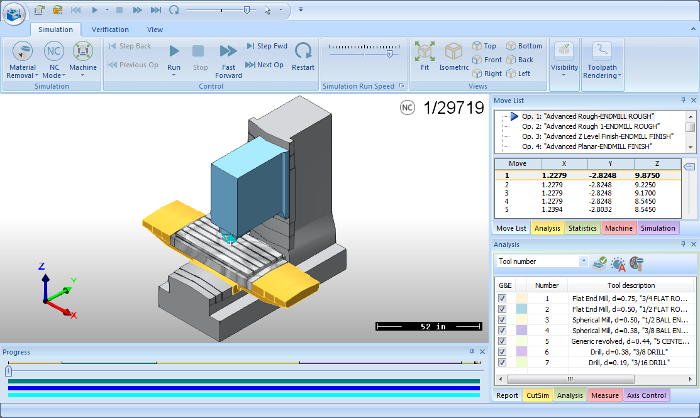
Simulation is an extremely powerful tool for viewing and analyzing the machining process. This tutorial reviews the main areas of the simulation interface and its major features to get you started successfully utilizing the power of toolpath simulation in Bob

Tip: In the Settings dialog, go to System > CAM > and select Separate Window in the Simulation group to launch the Simulation as a separate window instead of having its size limited to the graphics area.
There are two levels of simulation in BobCAD-CAM: Standard and Pro.
This provides a full-featured simulation engine that displays the stock, workpiece, and tool.
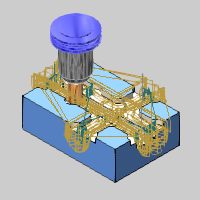
This provides the same functionality as the Standard Simulation and adds the ability to define a virtual machine so you can view the complete machine motion and even perform collision checking between machine components.
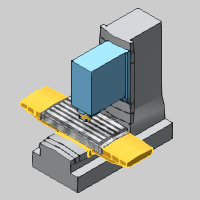
To open simulation, do one of the following:
 Start Simulation.
Start Simulation. .
. , or click the drop-down to select Simulate Selected.
, or click the drop-down to select Simulate Selected.
The Simulation tab of the ribbon bar contains many of the most used commands in simulation as explained next.
The Control group of the Simulation tab is used to navigate the program simulation. This includes the run, stop, next operation, and restart buttons. The speed slider of the Simulation Run Speed group controls how fast or slow the simulation runs.


Tip: You can use tool tips to help familiarize yourself with the toolbar buttons. To use tool tips, point to the button and wait a moment for the tool tip to display the button description.
The Simulation group of the Simulation tab contains three modes for the simulation: simulation type, playback mode, and simulation focus.

You can select either Toolpath Backplot mode or Material Removal mode.
![]() Backplot Mode
Backplot Mode
For this mode, the toolpath and workpiece display without any material removal.
![]() Material Removal Mode
Material Removal Mode
For this mode, the toolpath and the material removal display. Most of the powerful stock analysis tools are only available in this mode.
The display mode determines how the tool movement displays during playback.
 NC Mode
NC Mode
This mode displays the tool movement using the move list positions.
 Length Based Mode
Length Based Mode
This mode displays the tool movement at a constant speed.
 Time Based Mode
Time Based Mode
This mode displays the tool movement using real-time feedrates.
 Machine Focus
Machine Focus
With Machine Focus (available only for Machine Simulation Pro), the full virtual machine and its movement display in addition to the stock and workpiece.
 Workpiece/Stock Focus
Workpiece/Stock Focus
With Workpiece focus, the workpiece remains fixed and the tool moves.
 Tool Focus
Tool Focus
With Tool Focus, the tool remains fixed and the workpiece moves.
The Views group provides all of the standard viewing orientations and a fit to screen button.

The Visibility group allows you to select what elements display during simulation and their visibility status: visible, transparent, or hidden. You can control the visibility of the toolpath, tool, workpiece, stock, and the machine housing (Pro Simulation only).

The Toolpath Rendering group allows you to determine how the toolpath displays and what parts of the toolpath display. This includes displaying all operations, only the current operation, toolpath points, tool vectors, and whether or not lead and link moves display. You can also have the toolpath display only in areas the tool has already cut, hasn't cut, or a small segment before and after the current tool position.

The File tab provides access to the simulation Options, or the Machine Simulator Settings dialog box, so you can customize the simulation interface to your preferences, including keyboard shortcuts and mouse assignments. You can also access the Save/Export page to save the current stock, create a simulation report, or even export a functional presentation of your simulation to share with clients or employees.
The Move List contains a list of all operations and the tool moves for each operation. You can click an operation to go directly to that part of the program simulation. You can also drag the slider to go forward or backward in the simulation.
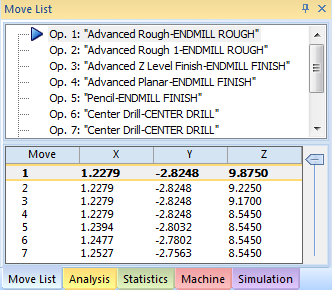
The Toolpath Analysis allows you to apply a coloring scheme to the toolpath. For example, you can display the toolpath for each operation or each tool in a different color. You can also select a scheme that applies colors to the toolpath based on a specific type of tool movement or change in movement. The colors can be fully customized.
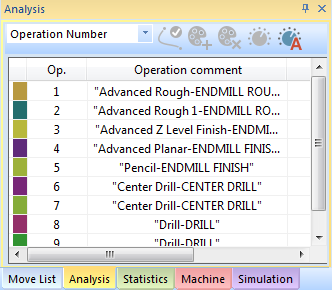
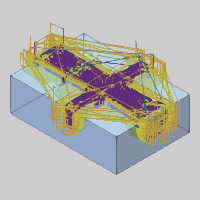
The ![]() Statistics provide important information about the current move, operation, or all operations, such as the feedrate and cycle time.
Statistics provide important information about the current move, operation, or all operations, such as the feedrate and cycle time.

The ![]() Report provides useful information about collisions that occur during the machining process, for example, a warning that manual position changes were not collision checked.
Report provides useful information about collisions that occur during the machining process, for example, a warning that manual position changes were not collision checked.

The Stock Analysis allows you to apply a coloring scheme to the stock model. For example, the cut stock material can display based on the operation number, tool number, or other criteria such as height change, angle change, or toolpath length. You can also perform deviation analysis to visualize the rest material.
The Deviation analysis allows you to compare the cut stock model to the target workpiece. You can set the range, gradients, number of colors, and even customize the colors used.
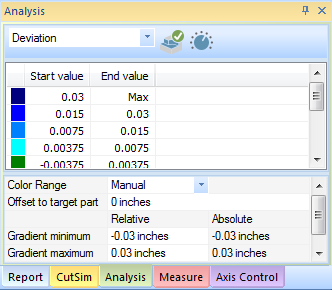
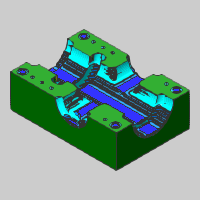
The Operation Number analysis displays all cut stock material with a separate color for each operation.
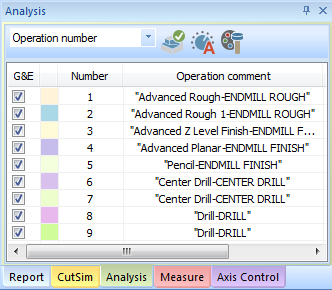
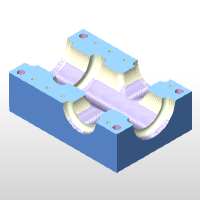
The Single Marking analysis displays all cut stock material using a single color.
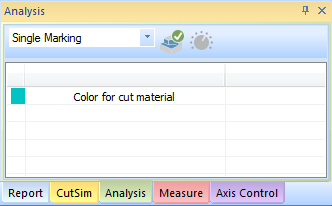
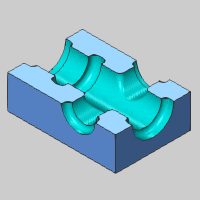
To close the simulation window, do one of the following:
 Stop Simulation.
Stop Simulation.
 in the upper-right corner of the simulation window.
in the upper-right corner of the simulation window.
Congratulations! You have completed the simulation overview tutorial. More usage examples of simulation are provided in the Getting Started CAM tutorials for each module. You can also view the Bob
After simulating a finished program, the next step in the process is to generate the NC program. To learn more, view Getting Started with Posting.